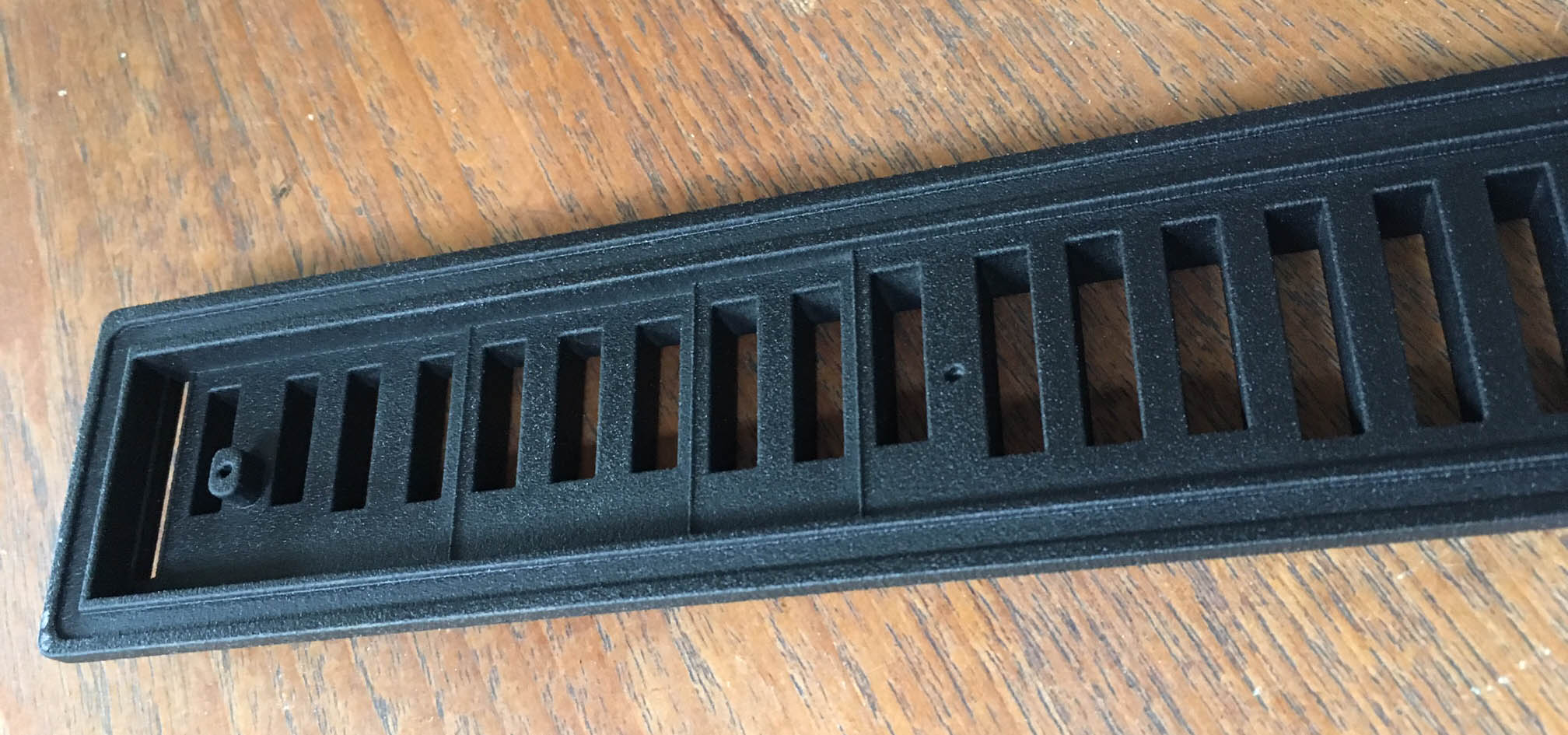A P37D with high quality reeds
- This topic has 18 replies, 5 voices, and was last updated 4 years, 1 month ago by
Indieventor.
-
AuthorPosts
-
September 11, 2017 at 12:34 pm #9305
 DarenKeymaster
DarenKeymasterI thought I’d share a recent experiment I made, in trying to retrofit high quality individual reeds to a Yamaha P37D. I first tried taking out the existing reeds, and replacing them with the new ones. There were 2 problems.
A) The depth of the cavities below the reeds were too shallow, resulting in the reeds touching the main body while vibrating. This produced a nasty sound. This could be avoided by playing very quietly, so the reeds tongues don’t vibrate so much.
B) The spacing of the cavities matched the original reed plates, and were in the wrong places for individual reeds. It meant I had to squash reeds together in some areas, and space them apart in other areas, to make room for the cover screws.
All the reeds sounded, and had a good basic tone.
Which made me think of designing a “conversion” panel which fits on top of the reed chamber, providing cavities with more depth, and the correct spacing for individual reeds. I had it 3D printed, and it came out very well. I fixed it permanently onto a P37 with “JB weld”, and waxed in some reeds.
The results were mixed. Most of the reeds sounded perfectly, but the top few simply wouldn’t sound. Sometimes there was a whistling sound. I think it must have something to do with the depth or shape of the cavities, which was now the new cavity, PLUS the cavity underneath.
I tried other reeds, with the same result, I tried turning the reeds upside down, with the same result. Not sure where to go from here…

 September 11, 2017 at 1:14 pm #9306
September 11, 2017 at 1:14 pm #9306 DarenKeymaster
DarenKeymasterSome opinions from outside the forum:
Tatu says that the cavities are too deep in the high notes. I could address this on the next design.
Martyn, a melodeon builder who showed me how to wax reeds offers another possible solution: “It could be the higher reeds are getting too much air and choking. On melodeons I usually get round this by making a small hole through the wax (about 1mm). This reduces the air pressure on the reed.”
So maybe I’ll try this first…
September 11, 2017 at 5:30 pm #9308 DarenKeymaster
DarenKeymasterBrendan, a master harmonica maker/player says this:
It sounds like the dreaded Helmholtz Resonance Coupling issue. Happens on high reeds in harmonicas also, when the comb chambers are too large and/or the reeds are a long way from the mouth. As one answer suggested, it’s probably your enlarged chambers that are having the bad effect on the high reeds.
Put a few high reeds back on the original setting block: do they sound well? If so, redesign your block so that you only have the enlarged cavities where needed, on the long low reeds which have a considerable swing. High reeds will have very little swing, so don’t need the compensation.
September 11, 2017 at 9:20 pm #9311 Alan BrintonParticipant
Alan BrintonParticipantFascinating experiment, Daren! It seems that it might be easier to get satisfactory results with a smaller number of reeds, for example with a P-25F. Then there’s also the possibility that what doesn’t quite work with a Yamaha would work with a Suzuki, or with a Hohner. A 1970-82 Suzuki Study 25 (A-25) might be a good platform. They are well constructed and plentiful.
The result of your 3D printing looks excellent.
September 12, 2017 at 7:32 am #9313 Melodica-MeParticipant
Melodica-MeParticipantDaren, can you narrow the hole to be slightly larger than the reed plate hole, it looks like you made them shorter in length, or have you already narrowed them, hard to tell with the reeds installed. One of the issues I had with the Diamante was the air chamber was to large so the lower reeds would choke, the higher notes were fine. the solution was to step the interior of the air chamber and create a wall between the last 6th and 12th lower notes that would allow less air to those notes. Is it possible to step the reed plate down in your custom plate so that the reed is closer to the original plate? or possibly fill the hole and bore a hole manually to see if this helps.
Melodica-MeSeptember 12, 2017 at 2:07 pm #9314 Shannon MParticipant
Shannon MParticipantDaren,
Other than the reeds that are not sounding, do you notice a significant difference in sound compared with the old reeds?
It is interesting that in comparing multiple air chambers, I have not seen one yet that does not route the air to the high notes first. They are also very shallow. Hard to tell from the pictures, but your adapter appears quite deep, which would significantly increase the volume of the air chamber. Higher volume, slower movement of air with a given input. Maybe not enough to activate the reeds. In other words, I think I agree with Brendan, although I have no idea what the dreaded Helmholtz Resonance Coupling issue is. I wouldn’t think the volume would be anywhere near what would be necessary to generate Helmholtz resonance. 8^)
Regards
Shannon
September 12, 2017 at 11:30 pm #9316 DarenKeymaster
DarenKeymasterAlan, yes, I’m sure it would work with a small model, and I do love those dinky retro melodicas. Unfortunately I need the extra high notes, for the music that I play.
MM, thanks for your insights – I’ll step the plate down when it gets to the last few reeds (its only the last 3 or 4), and also narrow the cavities, on the next redesign. But first I think I’ll try Martyn’s suggestion of making tiny holes in the wax, in case that works!
Hi Shannon, good question, and the reason why I wanted to try this experiment – to hear the difference between some of the cheapest and the most expensive reeds. And also to see how single, accordion style reeds would play in a plastic style melodica.
Tonally, the single reeds sound sweeter, purer and slightly thinner. Although they’re not a million miles away in timbre, there’s less harshness, particularly in the highest notes, which sound lovely on the expensive reeds. Another advantage of the single reeds are that the reeds sound with just the slightest breath pressure, so you have the potential of more expression.
I would hope they’d be more stable and need less tuning as well.
The downside is of course the expense of the reeds and the 3D printing, the extra weight and bulk, and the amount of work involved.
October 23, 2017 at 12:04 pm #9394 DarenKeymaster
DarenKeymasterMy new 3D printed part arrived today, looking forward to trying it out when I get to the studio. It steps down for the higher reeds, reducing the cavity size. It was sprayed black at the printers, which is a new thing they do. Should save me having to waterproof it.
 October 23, 2017 at 3:28 pm #9398
October 23, 2017 at 3:28 pm #9398 Melodica-MeParticipant
Melodica-MeParticipantPart looks great Daren, Can you post a picture once the reeds are installed and waxed in. I would love to hear it.
MMOctober 23, 2017 at 11:43 pm #9400 Alan BrintonParticipant
Alan BrintonParticipantCan’t wait to find out how this experiment works out, Daren. It could have significant melodica design implications.
October 24, 2017 at 10:58 pm #9403 DarenKeymaster
DarenKeymasterI’ll be back with some pictures and an update!
March 23, 2019 at 3:57 am #10682Indieventor
ParticipantHi Daren, this is a really interesting project, do you have any updates?
Might I ask where you got those individual reeds from or if you know of any good sources?Thanks!
SamMarch 23, 2019 at 10:45 am #10683 DarenKeymaster
DarenKeymasterHi Sam, I can’t actually remember the outcome, I must start keeping notes!
I can say it didn’t work out though. I think there may have been an improvement with the stepped design, but I decided at that point not to pursue the experiment any further.
The reeds are from:
HARMONIKAS s.r.o.
Poděbradova 2506
440 01 Louny+420 415 627 588
harmonikas@harmonikas.czhttps://www.harmonikas.cz/en/reeds-for-mouth-key-harmonicas#obsah
March 23, 2019 at 12:18 pm #10685Indieventor
ParticipantHi Daren,
Do you remember how much the set of reeds cost approximately? And did they require much more air to sound?
Thanks for the fast response, and this site!
SamMarch 29, 2019 at 7:57 pm #10691 DarenKeymaster
DarenKeymasterVery roughly £4 per reed as far as I can remember. Reed manufacturers tend to prefer dealing with businesses over private customers, so they’ll normally only be interested in selling several sets at a time. I bought 10 sets because I had a few things to try out!
They don’t take any more air to blow. One shortcoming of these accordion style reeds, and I’m not sure why, is that they choke quite easily with moisture build up, maybe because of the thicker tongues. It’s something I also find on the Vibrandoneons.
-
AuthorPosts
- You must be logged in to reply to this topic.
